#denarius
Text

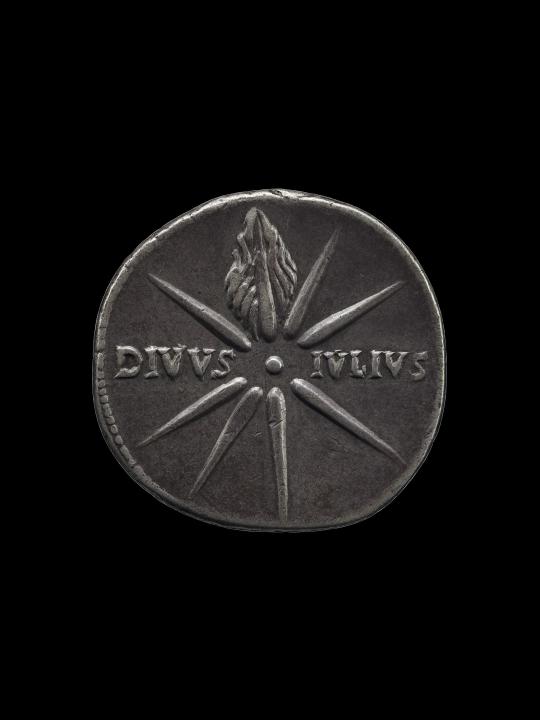
Denarius with head of Augustus wearing oak wreath (obverse) and comet with eight rays and inscription Divus Julius (reverse)
Roman (possibly minted at Caesaraugusta, modern Zaragoza in Spain), Imperial Period, 19-18 B.C.
silver
British Museum
#I love the coins of Augustus with representations of Caesar's Comet#I linked to the Wikipedia page if you want more info#denarius#Augustus#Julius Caesar#Caesar#Caesar's Comet#Divus Julius#Roman Empire#Augustan Period#Imperial Period#silver#coin#numismatics#British Museum
177 notes
·
View notes
Text
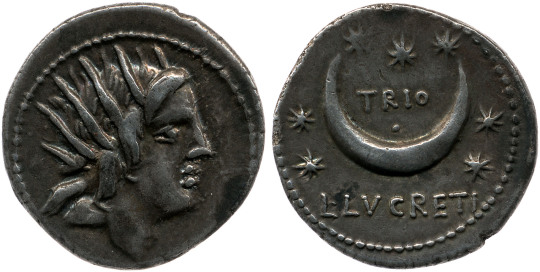
~ Denarius.
Moneyer: L. Lucretius Trio
Cultures/Period: Roman Republican
Date: 76 B.C.
Place of origin: Italy, Rome, Lazio
Medium: Silver
#ancient#ancient art#history#museum#archeology#roman#ancient history#archaeology#sol#denarius#coin#currency#stars#moon#lazio#silver#76 b.c.#lucretius
674 notes
·
View notes
Text
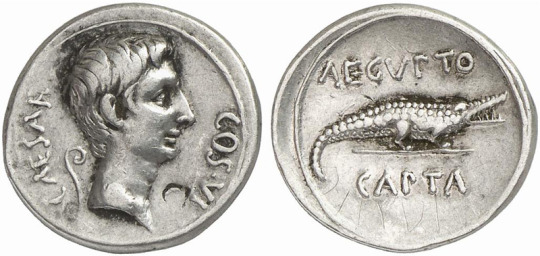
Silver denarius minted at Rome or Brundisium between 29 and 27 BCE by Julius Caesar's adopted son Octavian, soon to become Augustus. The denarius celebrates Octavian's conquest of Egypt following his (or, rather, Marcus Agrippa's) naval victory over Antony and Cleopatra at Actium. On the obverse, the bust of the young Octavian, with a lituus (ritual staff) showing his membership in the college of augurs; on the reverse, a crocodile surrounded by the inscription AEGYPTO CAPTA ("Egypt [having been] captured"). Beneath the inscription is a graffito from an unknown source. Photo credit: Classical Numismatic Group, Inc. http://www.cngcoins.com
#classics#tagamemnon#ancient history#Ancient Rome#Roman Empire#Roman history#Octavian#Augustus Caesar#Emperor Augustus#art#art history#ancient art#Roman art#Ancient Roman art#Roman Imperial art#coins#ancient coins#Roman coins#Ancient Roman coins#denarius#numismatics#ancient numismatics#metalwork#silver#silverwork
355 notes
·
View notes
Text

mosaic
#but also#DENARIUS of AUGUSTUS#'greek or roman. really who can say. greek probably right'#denarius#of. of augustus.#look hear me out#might be a wild stab in the dark but#i dont think thats a greek coin m8
35 notes
·
View notes
Text

Fulvia AR denarius issued by Marcus Antonius. Rome mint, ca. 42 BC, 3.5 gm, 17.0 mm. Ob. draped bust of Fulvia as victory. Rev. victory in biga holding reins of two horses. Inscribed, L MVSSIDIVS LONGVS
Mark Antony's 2nd wife Fulvia was the first roman woman to be portrayed on coins. Beautifully toned attractive portrait of Fulvia Flacca Bambula. Somewhat rough around the edges and the reverse struck slightly off center, otherwise, very fine.
#fulvia#mark antony#marcus antonius#numismatics#denarius#silver coins#roman coins#coins#ancient coins#ancient rome#rome#roman history#roman republic#roman empire
23 notes
·
View notes
Text
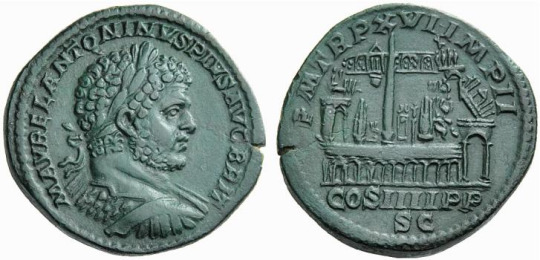
Sestertius of Caracalla, minted in 213 CE. Reverse depicts a view of the Circus Maximus.
Out of all the famous evil Roman Emperors, Caracalla is probably the least talked about. I really don't see much discussion about him.
Caracalla was born on the 4th of April, 188 in Lugdunum to Septimius Severus and Julia Domna. His heinous actions later in life can be attributed to his slow descent into degeneracy and growing rivalry with his brother Geta during their father's reign.
The most famous of Caracalla's heinous antics was the murder of his brother Geta, whom he utterly despised. Caracalla and Geta's relationship can be summarized as possibly the most destructive and petty sibling rivalry in Roman history. The rivalry ended up being so intense that when it came time for the two of them to ascend to the throne, they divided the imperial palace into two and almost divided the empire in half before being talked out of it by their mother. Caracalla didn't intend to share the throne for long though and planned to have Geta murdered.
On December 26th, 211, Caracalla had arranged for a reconciliation meeting that he had discussed with his mother about, telling her he wanted to make amends with Geta and move past their rivalry, and asked her to invite Geta to the meeting so that the three of them could work out their differences. Instead, during the meeting Caracalla had his guards burst into the room and slaughter Geta Infront of their mother. He then ordered massacre of anyone who associated with Geta, which included all classes of citizens. Around 20,000 people were massacred.
He also ordered that Geta's image was to be systematically erased throughout the empire, having his likeness erased from monuments and coins alike.
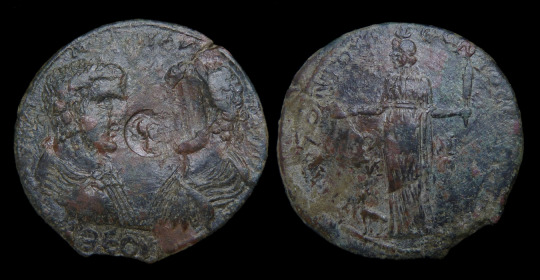
A formerly dual-portrait coin of Caracalla and Geta, with Geta's face hacked off.
One of the other atrocities that Caracalla committed was the massacre of Alexandria. There are differencing accounts of how and why the massacre happened, but the general narrative is that while Caracalla was visiting the city, the citizens openly mocked the murder of Geta and constantly jeered at Caracalla, which in turn made him plot their destruction. it is usually accepted that Caracalla went about the massacre by luring a large group of people into a confined area and then having his troops move in and slaughter them. The victims were either regular civilians, a group of his wealthy detractors, or young men hoping to be a part of a special unit Caracalla was raising for his eastern campaign. Either way it was an unnecessary bloodbath.
Finally, my favorite part of collecting Caracalla's coins is the way his portrait gets more and more pissed off over time.

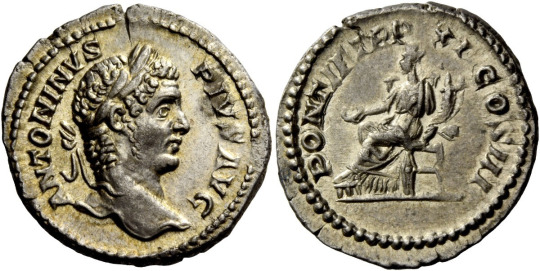

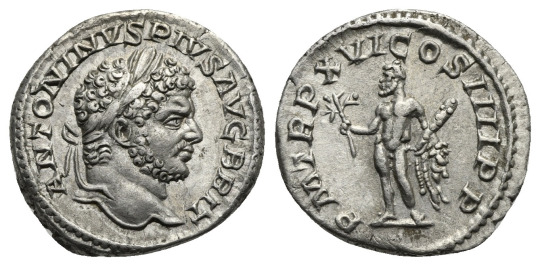

#ancient coins#ancient rome#roman history#ancient art#ancient history#classics#history#roman art#art#classical art#roman mythology#sestertius#denarius#caracalla#roman coins#classical mythology#evil roman emperor
9 notes
·
View notes
Photo
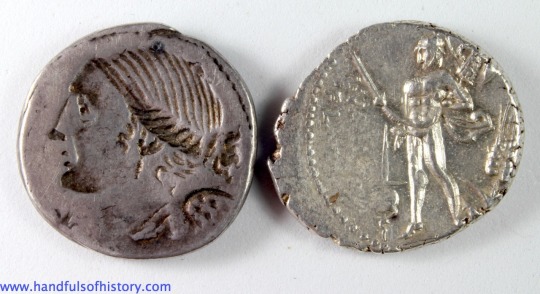
This coin minted in 108 BCE by the moneyer Valerius Flaccus has a type of defect, known as a brockage. It occurs when the coin previously struck sticks to the reverse die so the obverse of the previous coin acts as the reverse die creating a mirror image of the obverse on the reverse.
6 notes
·
View notes
Text
Quick Thought – Friday, April 19, 2024: What Would You Sacrifice?
Read
Matthew 26:6-13
But Jesus, aware of this, said to them, “Why do you trouble the woman? For she has done a beautiful thing to me.”Matthew 26:10
Reflect
How much is Jesus worth to you?
That’s a tricky question to ask since people so often assume that churches and ministries that ask such questions are only after their money. But with no strings attached, ask yourself, “How much of the money I…
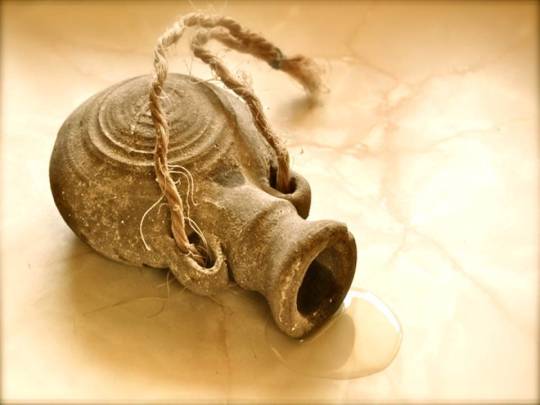
View On WordPress
#alabaster#denarii#denarius#extravagance#jar#Jesus#Judas#Lazarus#Mary#nard#Quick Thought#reflection#spikenard#valuable
0 notes
Link
0 notes
Text
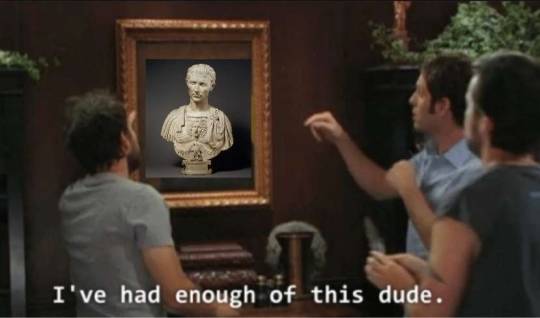
-Brutus and as many as 60 co-conspirators, circa March 14th, 44 BC
#ides of march#would you believe that I created this image all the way back in january STRICTLY BECAUSE I HAVE THAT MUCH BEEF WITH CAESAR?#this was created because he insisted that the Rhine was the border between Gaul and Germany#just so he could declare that he'd 'conquered' Gaul#but there's very little evidence that the peoples living in those places even viewed the Rhine as a barrier between lands#and their continued fighting against rome along that border line could indicate that they were in fact#attempting to reunite lands occupied by foreign invaders#anyway fuck you caesar i hope your triumph sucked ass#and that everyone who ever made bald jokes about you found idk a denarius in their pocket unexpectedly#yes i'm retroactively wishing dead people good and ill i'm complicated like that
6K notes
·
View notes
Text

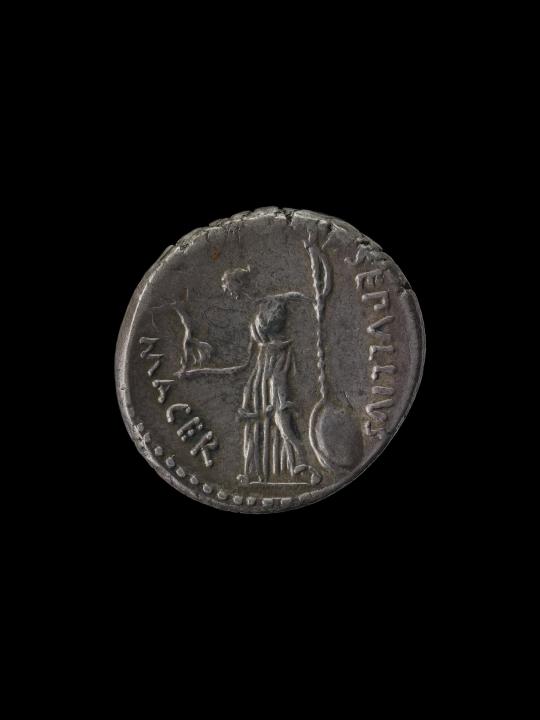
Denarius with head of Julius Caesar (obverse) and Venus holding Victory (reverse), minted under P. Sepullius Macer at Rome
Roman, Republican Period, 44 B.C.
silver
British Museum
#Ides of March#Julius Caesar#Caesar#Ancient Rome#Roman Republic#Republican Period#Rome#denarius#silver#coin#numismatics#Venus#Victory#British Museum
100 notes
·
View notes
Text
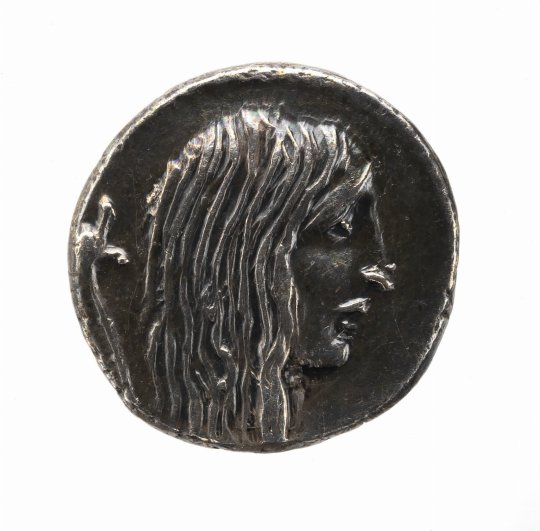

~ Denarius.
Place oforigin: Rome, Italy
Maker: Lucius Hostilius Saserna
Period: Republican Roman Period
Date: 48 B.C.
#ancient#ancient art#history#museum#archeology#archaeology#ancient currency#currency#denarius#long hair#diana#spear#stag#rome#roman empire#ancient roman#republican period#Lucius Hostilius Saserna#48 b.c.
527 notes
·
View notes
Text

Denarius of Lucius Aemilius Lepidus Paullus, future consul (50 BCE) and brother of the triumvir Lepidus, minted in 62 BCE. The obverse bears the figure of Concordia; historians have argued that Paullus (an adherent of Cicero) chose her to mark the restoration of civic concord following the defeat of Catiline. On the reverse, Lucius' namesake Lucius Aemilius Paullus, victor over King Perseus of Macedon at the Battle of Pydna in 168 BCE, is shown next to a trophy, with Perseus and his two sons as captives.
#classics#tagamemnon#history#ancient history#Ancient Rome#Roman Republic#Roman history#art#art history#ancient art#Roman art#Ancient Roman art#Roman Republican art#coins#ancient coins#Roman coins#Ancient Roman coins#denarius
95 notes
·
View notes
Note
Famous last words spoken by dictators:
Et tu Jar-Jar?
jar jar isn't a liberator, he's darth jar jar!! worst dictator of them all
#i mean unless he's killing dictators to take their power#which IS potentially brutus core! ides of march denarius of 43/42 bce im looking at u#thanks for the ask!
107 notes
·
View notes
Text
An Exceptional Roman Imperatorial Silver Denarius of Mark Antony, Possibly the Finest Example Known of this Scarce Issue. Minted in castrensis moneta in Greece (?) 42, AR 3.97 g.
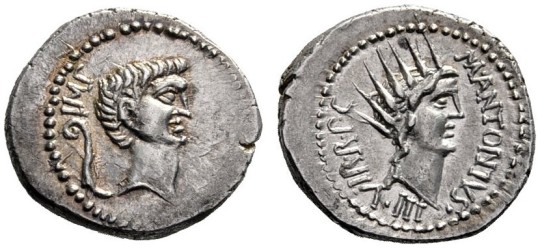
M. Antony AR denarius. Minted in castrensis moneta in Greece (?) 42 BC, Obv. IMP Head of Marcus Antonius, with light beard; behind, lituus. Rev. M ANTONIVS·III·VIR·R·P·C Radiate head of Sol.
Rare and in exceptional condition for the issue, possibly the finest specimen known. Light iridescent tone, virtually as struck.
#marc antony#mark antony#marcus antonius#denarius#roman coins#coinage#numismatics#rome#ancient rome#roman republic#roman empire#roman history
8 notes
·
View notes
Text
Obscure Imperial Era Romans (That Appeared on Coins) Part I
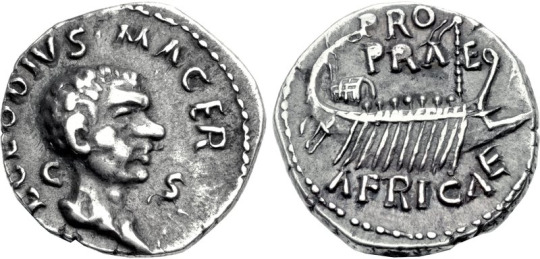
Coin of Clodius Macer, with Galley on reverse.
Clodius Macer, a high ranking military officer turned pirate, played a role in the beginnings of the civil war of 69 AD, being one of the men who first rebelled against Nero by raiding the north African coast, cutting off the food supply to the city of Rome, and generally being a pain in the ass.
It's reasonable to believe that Macer wanted to become emperor, but any plans he had were cut short when Galba had him killed. His coins are extremely rare, with only a few portrait denarii surviving the test of time.
he also looks goofy as hell
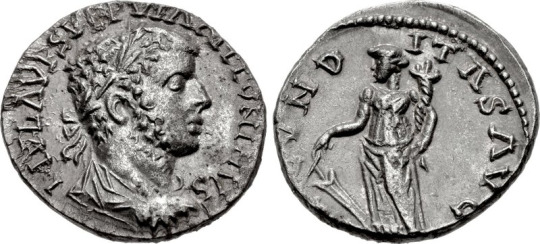
Coin of Uranius Anoninus, one of only three denarii known.
Uranius was active in the roman city of Emesa in Syria from 253-254 AD during Shapur's attacks on the eastern provinces. Imperial aid to most of the eastern cities was lacking due to the clusterfuck of the third century, so a local priest of the god Elagabal (the same god that Elagabalus is famous for worshipping) decided to step up and lead a militia comprised of other local Emesans. This militia succeeded in their goal of defending against Shapur.
The interesting is, this is one of the extremely ultra super rare occasions where someone who was put in a position of power during the third century clusterfuck didn't have strong imperial ambitions. It seems like Uranius only made coins to establish some sort of legitimacy within the area, and when the Persian threat was gone, Uranius most likely went back to being a priest.
Or he died, but we'll never know
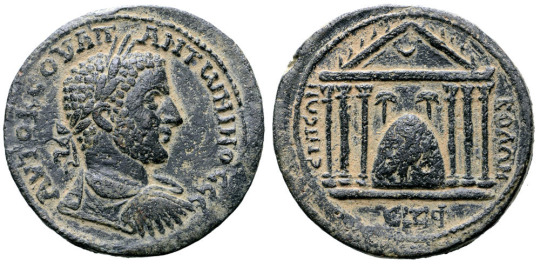
Uranius, with a temple for his favorite rock

Uranius throwing his rock a big parade
#ancient coins#ancient rome#roman history#roman usurpers#ancient history#ancient art#roman art#art#uranius antoninus#clodius macer#elagabalus's favorite rock 2: shapur boogaloo#denarius#aureus#history#archaeology#classics
3 notes
·
View notes